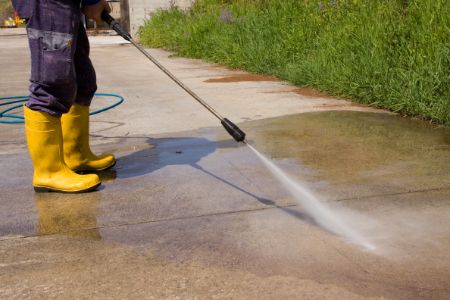Transform Your Commercial Property with Euclid Commercial Washing Services
Transform Your Commercial Property with Euclid Commercial Washing Services
Blog Article
Efficient Techniques for Graffiti Elimination That Restore Surface Areas to Their Original State
The challenge of graffiti elimination is complex, requiring an understanding of numerous graffiti types and the most effective strategies for reconstruction. From chemical solutions that cater to details paint structures to pressure cleaning methods that maintain the stability of surfaces, each approach has its merits.
Recognizing Graffiti Kind
Understanding the varied kinds of graffiti is important for effective removal techniques. Graffiti can be broadly classified into several types, each requiring various methods for elimination. The most usual types consist of throw-ups, tags, and murals. Tags are the simplest type, containing a stylized signature or logo design, commonly created rapidly with spray paint or pens. Their relatively small size can make them easier to get rid of but can still posture challenges depending upon the surface.
Throw-ups are much more complicated and typically involve larger, bubble-like text full of a solitary color. These pieces can cover extra area and may require various removal techniques contrasted to tags. Murals, on the various other hand, are elaborate art work that can be in-depth and rather large, typically appointed or created with permission. The elimination of murals provides special obstacles as a result of the potential for damages to the underlying surface and the imaginative value.
Understanding these distinctions is important for picking the right techniques and products for efficient graffiti elimination. Each kind not only differs in its aesthetic effect however additionally in the approaches that will be most reliable in recovering surfaces to their initial problem.
Chemical Removal Approaches
When dealing with graffiti removal, chemical approaches are frequently the most effective and effective strategy for different surfaces. These approaches utilize specialized formulas developed to damage down the chemical bonds in graffiti, making it easier to remove without damaging the underlying material.

It is necessary to select a chemical remover that works with the surface being treated to avoid damage. Examining the item on a little, low-profile area prior to extensive application is suggested. Additionally, proper safety equipment, such as masks and handwear covers, must be worn to guarantee safety and security throughout the elimination procedure.
Once the graffiti has been liquified, it is crucial to extensively rinse the surface to eliminate any type of chemical residue, which can result in staining or deterioration with time (Graffiti Removal in Euclid). Generally, chemical elimination techniques use an effective service for restoring surfaces to their initial state while decreasing prospective injury
Stress Cleaning Strategies
While chemical elimination approaches are highly effective, pressure washing presents an alternate strategy for graffiti elimination that can be similarly effective, specifically on durable surface areas. This technique utilizes high-pressure water jets to displace and remove graffiti from various products, such as concrete, block, and steel.
The performance of stress cleaning depend upon numerous elements, consisting of the stress setup, nozzle kind, and the range from which the water is used. Generally, a stress variety of 2,000 to 3,000 PSI is advised for many surface areas, yet modifications might be required depending upon the substrate's sensitivity. Making use of a fan spray nozzle can help cover bigger locations efficiently while reducing the threat of damaging the underlying product.
Before pressure cleaning, it is vital to examine the graffiti's make-up. Water-based paints commonly respond far better to this technique than irreversible or oil-based pens. Furthermore, pre-soaking the area with water can improve the removal procedure by lowering paint bond. After the pressure cleaning is full, surface areas must be examined for any type of staying deposit, and a second pass might be needed to attain optimal results. Overall, pressure washing is a powerful tool in the graffiti removal toolbox.

Eco-Friendly Solutions
Numerous people and organizations are significantly looking for green solutions for graffiti elimination, recognizing the significance of decreasing environmental impact. Conventional graffiti elimination methods commonly involve extreme chemicals that can be harmful to both the setting and public health. On the other hand, environmentally friendly solutions make use of non-toxic and eco-friendly materials that efficiently get rid of graffiti without triggering damage to surfaces or releasing damaging materials into the ambience.
One reliable technique is making use of all-natural solvents, such as citrus-based cleansers, which harness the power of plant-derived components to damage down paint without leaving harmful residues. In addition, baking soda and vinegar mixtures can act as mild abrasives that lift graffiti while being risk-free my blog for the atmosphere.
An additional cutting-edge approach is employing eco-friendly pressure cleaning systems that use much less water and power compared to standard techniques. These systems commonly incorporate specialized nozzles and eco-conscious cleaning agents that boost effectiveness while lowering waste.
Preventative Steps
Preventative procedures play an essential function in combating graffiti criminal damage and reducing its event. By carrying out calculated strategies, homeowner and neighborhoods can prevent possible wrongdoers and lower the prices related to graffiti elimination.
One effective method is using anti-graffiti finishings, which create a safety layer on surface areas, making it challenging for paint to adhere. These coatings can be colored or clear, enabling the initial visual to continue to be intact while offering a guard versus vandalism. Furthermore, the setup of monitoring cameras in high-risk locations can function as a deterrent, as the presence of keeping an eye on modern technology may dissuade prospective wrongdoers.
Neighborhood interaction is likewise essential; arranging community watch programs or graffiti clean-up occasions cultivates a feeling of ownership and satisfaction amongst citizens. Educational efforts in institutions can increase understanding about the negative effects of graffiti, advertising regard for public and personal residential property.
Conclusion
In final thought, the effective elimination of graffiti requires visit the website a complex method that takes into consideration the type of graffiti and the surface area material. A detailed understanding of these approaches is crucial for accomplishing optimum results in graffiti elimination ventures.

Report this page